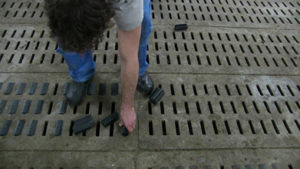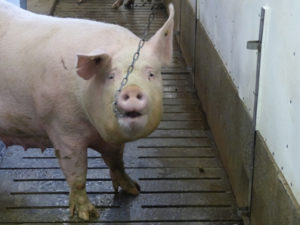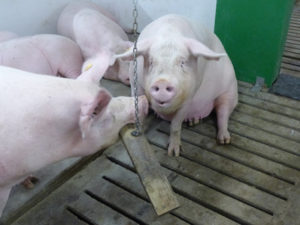Ventilation System Requirements for Conversion to Group Sow Housing
Posted in: Pork Insight Articles, Prairie Swine Centre, Production by student on June 11, 2018 | No Comments
When converting to group housing for sows if remodeling of the previous ventilation systems does not occur, it is estimated that over-ventilating will occur at a rate of 30%. This will raise the heating energy consumption by 75% in the winter. Carefully redesigning the ventilation system will aid in ensuring optimal pig health as well as reducing energy costs. Through the use of computer stimulation it was determined that utilizing a horizontal flow ventilation system (having the air inlets located opposite to the exhaust fans) resulted in the air being most effectively homogeneously mixed. Utilizing the horizontal flow ventilation system (HFVS) an in-barn evaluation was carried out to determine the ventilation effectiveness on temperature and HRE (heat removal effectiveness), air quality, sow condition and performance, and the behavior of the sow. When comparing the remodeled ventilation system to the unmodified system it is apparent that the modified system more effective at removing heat and contaminants (such as CO2) from the room. In the room equipped with the HFVS the sows displayed a higher level of comfort and were overall less aggressive towards other sows. The in barn evaluation determined that when comparing a converted room with an unmodified ventilation system to group housing with a HFVS that the HFVS resulted in a 21% reduction in natural gas consumption and a 14% reduction in electricity consumption.
Ventilation System Requirements for Conversion to Group Sow Housing – 2017
National Sow Housing Conversion Project
Posted in: Pork Insight Articles, Prairie Swine Centre by Ken Engele on May 1, 2018 | No Comments
The National Sow Housing Conversion Project (NSHCP) is a descriptive project intended to facilitate the successful conversion of Canada’s sow barns to group housing. The project involves collaboration from industry participants and academic researchers across Canada working together on a comprehensive strategy involving demonstration farms and technology transfer materials and events to support Canadian pork producers. This report describes progress up to year 3 of this 4 year project. The project is a collaboration between the University of Manitoba, Manitoba Pork Council, CDPQ and the Prairie Swine Centre. The full project will collect detailed information on fourteen barn sites across the country that have implemented group sow housing. The information collected is in the form of questionnaires, interviews, photos, videos, barn layous and production and economic data. The results are being made available to producers through producer meetings and presentations, newsletters, and a comprehensive
website: www.groupsowhousing.com.
Determining Effective Enrichments for Group Housed Sows
Posted in: Pork Insight Articles, Prairie Swine Centre by Ken Engele on | No Comments
It was concluded that when enrichment was rotated (Rotation and Stimulus treatments) sows spent more time near enrichments and were more active than when Constant enrichment or Control treatments were provided. Based on this initial analysis the sound stimulus appeared to have no significant effect. Although the straw enrichment produced the greatest response, sows also made use of rope and wood on chain enrichments, and no adverse effects were found for sows or manure management indicating their suitability as enrichment materials for group-housed sows.
Practical Alternatives for Managing Castration Pain in Piglets
Posted in: Pork Insight Articles, Prairie Swine Centre by Ken Engele on | No Comments
The objective of this project was to identify which analgesics will provide optimal pain relief to piglets; at what age castration should be performed to minimize stress and production losses in piglets; determine if the timing of drug administration affects piglets’ pain responses following castration and whether provision of oral sucrose prior to an analgesic can provide measureable benefits to pigs during the initial pain of castration. The first study evaluated the effectiveness of three non-steroidal anti-inflammatory drugs (NSAIDS) on post-castration pain. The second compared the influence of age at castration (3 days vs 10 days) on piglet welfare. Initial behavioural results from these two experiments found no significant differences in chute navigation times among the treatments studied. In study 2, the expected differences between sham handled and castrated piglets were not found, and no benefits of drug treatment were observed even though drugs were administered 15 minutes prior to testing.
Cleaning Ease and Animal Welfare Implications of Trailer Design
Posted in: Pork Insight Articles, Prairie Swine Centre by Ken Engele on | No Comments
The aim of this initial study was to develop an inventory list of trailers commonly used for the transportation of market hogs in Canada. Hog transport companies in Saskatchewan, Manitoba and Ontario were visited
in order to document various trailer features specifically those influencing ease of cleaning and animal handling characteristics. Each trailer design was ranked according to cleaning ease, animal handling and welfare
characteristics. In addition to a trailer inventory, a questionnaire was developed and transport companies were interviewed to gain further insight into trailer design and usage.
High Fibre Diets for Swine
Posted in: Pork Insight Articles, Prairie Swine Centre by Ken Engele on April 23, 2018 | No Comments
Feed cost represents more than 60% of the variable cost of swine production and a major part of the feed cost is to ensure that pigs have adequate energy and protein supply to reach their optimum potential in terms of the production goals. Corn, wheat, barley, and soybean meal have been the most widely used feedstuffs to meet the energy and protein requirements of pigs. However, the prices of these conventional feedstuffs continue to rise and have been unpredictable in recent years. Therefore, swine producers have to find alternative feed resources to ensure economic sustainability of their business. Currently, canola meal and cereal grain co-products from the biofuel and milling industry are commonly used for pig feed in Western Canada because of their availability, low-cost and nutrient content. However, these alternative feed resources are typically fibrous in nature and when fibrous ingredients are incorporated into pig diets; the carbohydrate composition inevitably changes from a high starch diet toward a diet containing less starch and more non-starch polysaccharides, which are the major component of dietary fiber. Starch and dietary fiber, however, differ in several aspects apart from their chemical structures. For instance, whereas starch is mostly digested and absorbed in the small intestine, fiber is not digested in the small intestine of pigs because monogastric do not produce the digestive enzymes that break down fiber. However, some fiber types can be fermented by the microbes in the pig’s intestinal tract. Further, dietary fiber has the potential to reduce energy and nutrient digestibility and consequently depress pig growth performance. However, the reports have been rather contradictory and the negative effects of fiber-rich diets on nutrient utilization and pig growth are influenced by the fiber source, type, and inclusion level. On the other hand, dietary fiber has received a lot of attention in swine nutrition in recent years because some fiber components have beneficial effects on pig gut health when fermented in the intestine, and can positively affect gestating sow welfare.
High Fiber Diets for Swine (Agyekum)
Prairie Swine Centre CEO Appointment
Posted in: Pork Insight Articles, Prairie Swine Centre, Press Releases by Ken Engele on April 16, 2018 | No Comments
Prairie Swine Centre
James Reesor, Chairman of the Board
Dr. Murray Pettitt Appointed New CEO of Prairie Swine Centre
FOR IMMEDIATE RELEASE
Saskatoon, April 12, 2018 – The Board of the Centre has announced the appointment of Dr. Murray Pettitt as their new CEO. Murray will assume responsibilities on July 1, 2018 and will succeed Lee Whittington, who is retiring after 26 years, the last 10 years as President/CEO.
Dr. Pettitt has been part of the swine research community for the past 21 years, and was previously employed at Prairie Swine Centre (PSC) for 10 years, managing Contract Research from 2003-2009. During that time he grew the program’s size and capabilities, while being responsible for the business development as well as the design and implementation of customer-driven research.
“It is like coming home – to be able to return to the Centre after 9 years pursuing my research interests in my area of specialization” notes Murray. “The position of CEO will allow me to further my interests in bringing science to agriculture, and adding to the long, successful history of Prairie Swine Centre’s service to the pork industry”.
Background:
Murray is from rural Manitoba and received his BSA in 1986 and his M.Sc. in animal reproduction in 1991 from the University of Manitoba. After three years at the Winnipeg Health Sciences Centre, he returned to agriculture to pursue research in boar sperm cryopreservation at the University of Guelph, receiving his Ph.D. in 1997. Murray accepted a post-doctoral fellowship at the Ontario Veterinary College where he helped develop practical embryo transfer techniques in swine.
In 1999, he assumed the position of Assistant Manager – External Research Services (also known as Contract Research) at PSC. Subsequently he became the Research Scientist – External Research Services from 2003 – 2009 where he was responsible for leading this program.
Since leaving PSC, Murray has been at the Department of Animal and Poultry Science at the University of Saskatchewan where he was responsible for managing a research program investigating markers of sperm function to identify the fertility potential of boars and bulls.
The Company:
Prairie Swine Centre Inc., located near Saskatoon, is a non-profit research corporation affiliated with the University of Saskatchewan, and is recognized globally for its contributions to practical, applied science, training and knowledge transfer in pork production with emphasis in the disciplines of nutrition, engineering, and applied animal behavior.
For further Information Contact:
Prairie Swine Centre
Lee Whittington
306-667-7447
-30-
2018 Prairie Swine Centre Producer Meetings
Posted in: Pork Insight Articles, Prairie Swine Centre, Press Releases by Ken Engele on April 6, 2018 | No Comments
2018 Producer Meetings
| Tuesday, April 24th
Strathmore, Alberta Travelodge Hotel 1150 – 350 Ridge Road |
Wednesday, April 25th
Swift Current, Saskatchewan Days Inn 905 North Service Road E |
Friday, April 27th
Niverville, Manitoba Niverville Heritage Centre 100 Heritage Trail |
Time: 10:00 a.m. – 2:30 p.m.
9:30 REGISTRATION
Lunch will be provided
PROGRAM
Feed Processing for Improved Production, Denise Beaulieu, University of Saskatchewan
- Feed processing can have significant impact on performance of your herd. What are the management strategies producers should examine within their milling to maximize mill and herd performance?
Exercising sows – What producers need to know?, Yolande Seddon, University of Saskatchewan
- Changes to the Code require producers in the future to provide periodic greater freedom of
movement to sows. Are sows motivated for a greater freedom of movement, and how can this be adopted on farm?
The Evolution of Genetic Potential, Daniel Godbout, PIC Canada Ltd.
- A walk through time to look where we were 50 years ago, what has been accomplished, how it has been accomplished and what the future holds. Pigs have changed dramatically and nutrition and management approaches have too. We need to bring it all together to achieve the greatest success.
Pig Tales – Ongoing Benefits of Colostrum, Leanne Van De Weyer, Zoetis
- Colostrum is critical for pig health and performance beyond the pre-weaning phase. What can producers do to ensure all piglets get their “fair share”?.
The NSERC IRC in Swine Welfare – Benefits for the pork value chain, Yolande Seddon, University of Saskatchewan
- The Chair is an opportunity to contribute to advancing sustainable production systems that will add to the scientific understanding of methods to improve animal welfare and identify progressive management approaches.
A Look Back – A Look Forward: Prairie Swine Centre at Your Service, Lee Whittington, PSCI
- In 2017 Prairie Swine Centre is celebrating 25 Years. We will take a walk through this period and examine the greatest accomplishments that benefits producers and where we are headed in the future?
To register for this seminar, please contact:
| Prairie Swine Centre would like to thank PIC Canada and Zoetis for their sponsorship and promotion of these meetings |
Improved Laying Areas for Sows
Posted in: Pork Insight Articles, Prairie Swine Centre, Swine Innovation by Ken Engele on March 23, 2018 | No Comments
Improving the Laying Area for Gestating Sows
This video clip contains testimonials from hog producers who participated in a project focused on strategies to improve laying areas for gestating sows housed in groups. As part of this project, devices to fill the gaps between slats were installed in the sow pens (Photos 1 and 2).
Three farms across Canada participated in this project and we would like to thank these producers:
Mr. Geert Geene, Amberley Bacon Company
Mr. Francis Veilleux, Ferme porcine L.V.
Mr. Ken Waldner, Matador Colony

Photo 1: Mr. Geert Geene, Amberley Bacon Company, installing « slat gap covers » to fill the spaces between the slats

Photo 2: Sows sleeping on the section with « slat gap covers »
For more information:
Optimizing flooring and social management of group housed gestating sows
Acknowledgments:
This project was funded by Swine Innovation Porc within the Swine Cluster 2: Driving Results Through Innovation research program. Funding was provided by Agriculture and Agri‐Food Canada through the AgriInnovation Program, provincial producer organizations and industry partners.


Environmental Enrichment Strategies for Sows
Posted in: Pork Insight Articles, Prairie Swine Centre, Swine Innovation by Ken Engele on March 22, 2018 | No Comments
ENVIRONMENTAL ENRICHMENT STRATEGIES FOR GROUP-HOUSED SOWS
Summary: This video clip contains testimonials from pig producers who participated in a project to enrich the living space of gestating sows housed in groups. Six farms across Canada participated in this project and three different enrichment items were installed in the sow pens (Photos 1 to 6):
- A chain suspended from the ceiling, the end of which is approximately 10 cm (4 in.) above the floor (Photos 2 and 3);
- A piece of wood suspended by a chain, set at a height of 81 to 91 cm (32-36 in.) above the floor (Photos 4 and 5). The height corresponds to the average height of a trough, about the height of a sow’s nose;
- A Porcichew toy (ring of aromatic plastic), suspended by a chain, fixed at a height of 81 to 91 cm (32-36 inches) above the floor (Photo 2). The height corresponds to the average height of a drinking trough, about the height of a sow’s nose (photo 6).
We would like to thank the following Canadian hog producers who participated in this project:
Mr. John Van Engelen, Hog Tied Farms
Mr. Geert Geene, Amberley Bacon Company
Mr. Tom Kennelly, Sunhaven Farms
Ms. Christine Marcotte, Ferme Sainte-Catherine
Mr. Francis Veilleux, Ferme porcine L.V.
Mr. Ken Waldner, Matador Colony

Photo 1: The three enrichment items installed in the same pen at the Amberley Bacon Company farm (chain, Porcichew and piece of wood).

Photo 2: Chain anchored in the ceiling

Photo 3: Sow playing with the chain

Photo 4: Installation of the piece of wood, fixed on a chain

Photo 5: Sows playing with the piece of wood

Photo 6: Porcichew
For more information:
Optimizing flooring and social management of group housed gestating sows
http://www.swineinnovationporc.ca/resources/Annual_Reports/2016-2017/WELFARE%201231%20Flooring%20and%20social%20mangement%20of%20sows%202017.pdf
Enriching the living space of pigs to comply with the Code
Acknowledgments:
This project was funded by Swine Innovation Porc within the Swine Cluster 2: Driving Results Through Innovation research program. Funding was provided by Agriculture and Agri‐Food Canada through the AgriInnovation Program, provincial producer organizations and industry partners.











